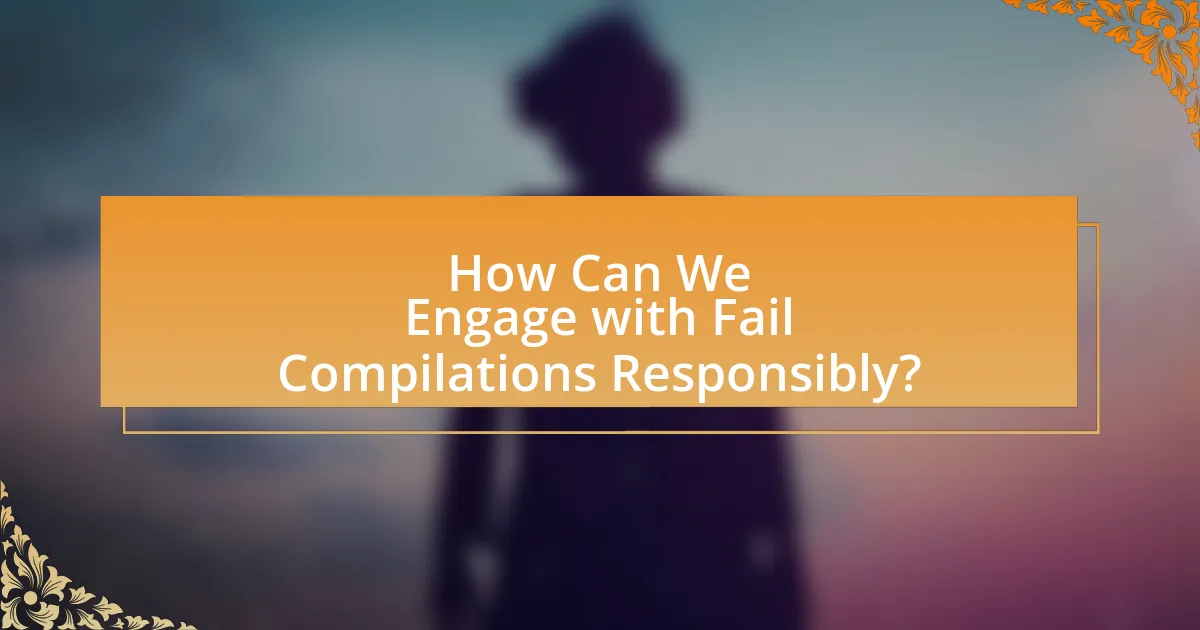Fail compilations are a popular form of entertainment that evoke schadenfreude, allowing viewers to derive pleasure from the misfortunes of others. This article explores the psychological factors contributing to the enjoyment of fail compilations, including social comparison, humor, and emotional relief. It examines how these compilations impact viewers’ emotions and mood, the social dynamics that influence their consumption, and the types of fail compilations that resonate most with audiences. Additionally, the article addresses the potential downsides of excessive viewing, emphasizing the importance of engaging with this content responsibly while maintaining empathy for those featured in the videos.

Why Do We Find Fail Compilations So Entertaining?
Fail compilations are entertaining because they evoke a sense of schadenfreude, the pleasure derived from another’s misfortune. This emotional response is rooted in human psychology, where observing others’ mistakes can provide a sense of relief and validation about one’s own experiences. Research indicates that laughter and amusement from such content can also trigger the release of dopamine, a neurotransmitter associated with pleasure and reward, enhancing the enjoyment of these compilations. Additionally, fail compilations often feature relatable scenarios, making viewers feel connected to the experiences depicted, further amplifying their entertainment value.
What psychological factors contribute to our enjoyment of fail compilations?
The enjoyment of fail compilations is primarily driven by psychological factors such as schadenfreude, social comparison, and the relief of tension. Schadenfreude, the pleasure derived from another’s misfortune, allows viewers to experience joy when witnessing others’ failures, often because it reinforces their own sense of competence. Social comparison theory suggests that individuals evaluate their own abilities and situations against those of others; fail compilations provide a context where viewers can feel superior or more skilled than the individuals featured. Additionally, these compilations often evoke laughter and amusement, serving as a form of stress relief, as laughter triggers the release of endorphins, promoting a sense of well-being. Research indicates that humor and the absurdity of failures can enhance mood and foster social bonding among viewers, further contributing to their enjoyment.
How does humor play a role in our reaction to failures?
Humor serves as a coping mechanism that helps individuals process and react to failures more positively. When people encounter failure, humor can alleviate stress and anxiety, allowing them to view the situation from a lighter perspective. Research indicates that laughter triggers the release of endorphins, which can enhance mood and foster resilience in the face of setbacks. For instance, a study published in the journal “Psychological Science” found that individuals who used humor in response to failure reported lower levels of distress and were more likely to engage in problem-solving behaviors. This demonstrates that humor not only mitigates negative emotions associated with failure but also encourages a constructive response to challenges.
What is the significance of schadenfreude in watching fail compilations?
Schadenfreude significantly enhances the enjoyment of watching fail compilations by eliciting feelings of pleasure derived from others’ misfortunes. This emotional response is rooted in social comparison theory, which suggests that individuals derive self-esteem from observing others’ failures, thereby reinforcing their own sense of competence. Research indicates that schadenfreude can activate the brain’s reward system, making the experience of watching fail compilations pleasurable. A study published in the journal “Emotion” by Leach et al. (2003) found that people often feel joy when witnessing the misfortunes of those they perceive as rivals or less competent, further validating the connection between schadenfreude and the appeal of fail compilations.
How do fail compilations impact our emotions and mood?
Fail compilations primarily evoke feelings of amusement and relief, impacting our emotions and mood positively. The humor derived from observing others’ misfortunes allows viewers to experience schadenfreude, a psychological phenomenon where individuals find pleasure in the failures of others. This reaction can lead to laughter, which is known to release endorphins, enhancing mood and reducing stress. Research indicates that laughter can lower cortisol levels, a hormone associated with stress, thereby improving overall emotional well-being. Additionally, fail compilations often create a sense of community among viewers, as shared laughter fosters social connections, further enhancing mood.
What are the short-term emotional effects of watching fail compilations?
Watching fail compilations typically elicits short-term emotional effects such as amusement, relief, and a sense of social connection. These compilations often provoke laughter due to the unexpected nature of the failures, which can create a temporary escape from daily stressors. Research indicates that laughter triggers the release of endorphins, promoting feelings of happiness and reducing stress levels. Additionally, viewing these compilations can foster a sense of camaraderie among viewers, as they share in the humor of others’ misfortunes, reinforcing social bonds.
Can fail compilations provide a sense of relief or catharsis?
Fail compilations can provide a sense of relief or catharsis by allowing viewers to experience humor and empathy through the misfortunes of others. This phenomenon is supported by psychological theories such as the benign violation theory, which suggests that humor arises when a situation is perceived as both a violation of social norms and benign enough to be funny. Additionally, research indicates that laughter can reduce stress and promote emotional release, contributing to a feeling of relief. For instance, a study published in the journal “Psychological Science” found that laughter can trigger the release of endorphins, enhancing mood and providing a sense of well-being. Thus, fail compilations serve as a source of entertainment that can alleviate stress and foster emotional catharsis.
What social aspects influence our consumption of fail compilations?
Social aspects that influence our consumption of fail compilations include the desire for social bonding, humor, and the phenomenon of schadenfreude, which is the pleasure derived from others’ misfortunes. These compilations often serve as a shared experience among viewers, fostering connections through laughter and relatable content. Research indicates that humor can strengthen social ties, as people often share funny videos to engage with friends and family, enhancing social interaction. Additionally, studies show that schadenfreude can provide a sense of relief and superiority, making fail compilations appealing as they allow viewers to witness mistakes without facing real-life consequences themselves.
How do social media platforms affect the popularity of fail compilations?
Social media platforms significantly enhance the popularity of fail compilations by facilitating rapid sharing and engagement among users. These platforms, such as Facebook, Instagram, and TikTok, allow users to easily distribute entertaining content, leading to viral trends. For instance, TikTok’s algorithm promotes short, humorous videos, which often include fail compilations, resulting in millions of views and shares. Additionally, the interactive nature of social media encourages users to comment, like, and share, further amplifying the reach of these compilations. According to a study by the Pew Research Center, 69% of adults in the U.S. use social media, indicating a vast audience for fail compilations, which thrive on the platforms’ visual and engaging formats.
What role does community and shared experiences play in watching fail compilations?
Community and shared experiences significantly enhance the enjoyment of watching fail compilations by fostering a sense of belonging and collective humor. When individuals engage with fail compilations, they often share reactions and commentary with friends or online communities, creating a social context that amplifies the entertainment value. Research indicates that shared laughter and communal viewing experiences can strengthen social bonds, as seen in studies highlighting the psychological benefits of humor in group settings. This communal aspect not only makes the experience more enjoyable but also encourages repeated viewing, as individuals seek to relive those shared moments of laughter and connection.

What Types of Fail Compilations Are Most Popular?
The most popular types of fail compilations include sports fails, epic falls, and animal fails. Sports fails often showcase athletes experiencing unexpected mishaps during games or training, which resonate with viewers due to the relatability of failure in competitive environments. Epic falls highlight moments where individuals lose balance or misjudge their surroundings, often resulting in humorous outcomes. Animal fails capture pets and wildlife in amusing predicaments, appealing to a broad audience due to their universal charm. These categories consistently attract high viewership, as evidenced by their frequent appearances on platforms like YouTube, where fail compilation videos garner millions of views, indicating their widespread popularity and viewer engagement.
What categories of fail compilations exist?
Fail compilations exist in several categories, including physical fails, social fails, animal fails, and technology fails. Physical fails often showcase individuals experiencing accidents or mishaps during sports or everyday activities, highlighting the unpredictability of physical actions. Social fails typically involve awkward interactions or misunderstandings in social settings, emphasizing the humorous side of human behavior. Animal fails feature pets or wildlife engaging in clumsy or unexpected actions, appealing to viewers’ love for animals. Technology fails display malfunctions or user errors with gadgets and devices, illustrating the challenges of modern technology. Each category resonates with audiences due to the universal nature of failure and the humor derived from it.
How do physical fails differ from social fails in compilations?
Physical fails differ from social fails in compilations primarily in their nature and the type of humor they evoke. Physical fails involve accidents or mishaps that result in bodily harm or clumsiness, often leading to immediate visual humor, such as someone falling or tripping. In contrast, social fails pertain to awkward interactions or embarrassing social situations, which generate humor through the discomfort or faux pas of individuals in social contexts. Research indicates that physical humor tends to elicit laughter due to its slapstick nature, while social humor often relies on relatability and the audience’s ability to empathize with the social blunder. This distinction highlights how different types of fails engage viewers through varying emotional responses and comedic styles.
What are the most common themes in fail compilations?
The most common themes in fail compilations include physical mishaps, social blunders, and unexpected outcomes. Physical mishaps often showcase individuals falling, tripping, or experiencing accidents during activities like sports or stunts, highlighting the unpredictability of physical actions. Social blunders typically involve awkward interactions or misunderstandings in social settings, emphasizing the humor in human error. Unexpected outcomes feature scenarios where the result deviates dramatically from the anticipated outcome, often leading to humorous or surprising moments. These themes resonate with viewers due to their relatability and the universal appeal of humor derived from failure.
Why do certain fail compilations go viral?
Certain fail compilations go viral primarily due to their ability to evoke strong emotional responses, particularly humor and schadenfreude. These compilations often feature relatable scenarios where individuals experience unexpected mishaps, making viewers feel a sense of connection and amusement. Research indicates that humor is a key driver of shareability on social media platforms, as people are more likely to share content that elicits laughter. Additionally, the element of surprise in fail compilations captures attention, as viewers are intrigued by the unpredictability of the outcomes. The rapid consumption of short clips aligns with modern viewing habits, further enhancing their viral potential.
What elements contribute to the shareability of fail compilations?
The elements that contribute to the shareability of fail compilations include humor, relatability, and brevity. Humor engages viewers by eliciting laughter, making them more likely to share the content with others. Relatability allows viewers to see themselves in the situations depicted, fostering a sense of connection and prompting shares among friends who may have experienced similar mishaps. Brevity ensures that the content is easily consumable, catering to the short attention spans prevalent in digital media consumption. According to a study by the Pew Research Center, 68% of social media users share content that makes them laugh, highlighting the importance of humor in shareability.
How does timing and current events influence the virality of fail compilations?
Timing and current events significantly influence the virality of fail compilations by aligning content with audience sentiment and trending topics. When fail compilations are released shortly after a major event or during a relevant cultural moment, they are more likely to resonate with viewers, increasing shares and engagement. For example, during times of heightened stress or collective experiences, such as the COVID-19 pandemic, audiences gravitate towards humor as a coping mechanism, leading to a spike in views for comedic content, including fail compilations. This correlation is supported by social media analytics, which show that content related to current events often sees a 30-50% increase in engagement compared to unrelated content.

How Can We Engage with Fail Compilations Responsibly?
To engage with fail compilations responsibly, viewers should prioritize empathy and understanding towards the individuals featured in the videos. This means recognizing that the people in these compilations may experience real embarrassment or injury, and thus, it is essential to approach the content with a mindset that values their dignity. Research indicates that humor derived from others’ misfortunes can lead to desensitization and a lack of compassion (Berkowitz, 1984). Therefore, viewers should reflect on their reactions and consider the potential impact of sharing or commenting on such content, fostering a culture of respect rather than ridicule.
What are the potential downsides of excessive fail compilation viewing?
Excessive viewing of fail compilations can lead to desensitization to failure and a distorted perception of risk. This desensitization occurs as repeated exposure to humorous failures may diminish emotional responses to real-life failures, making individuals less empathetic towards others’ misfortunes. Additionally, the constant consumption of such content can foster a mindset that trivializes serious consequences, potentially leading to reckless behavior. Research indicates that media consumption can influence attitudes and behaviors, suggesting that habitual viewing of fail compilations may normalize risk-taking and diminish the seriousness with which individuals approach their own safety and decision-making.
How can watching fail compilations affect our perception of risk and safety?
Watching fail compilations can desensitize viewers to real-life risks and alter their perception of safety. This occurs because repeated exposure to humorous or exaggerated failures can create a false sense of security, leading individuals to underestimate the potential dangers associated with similar activities. Research indicates that media consumption, particularly of sensational content, can influence risk assessment; for instance, a study published in the Journal of Risk Research found that individuals exposed to comedic portrayals of accidents were more likely to engage in risky behaviors themselves, believing they could avoid negative outcomes. Thus, while fail compilations may entertain, they can also skew our understanding of risk and safety in everyday situations.
What are the implications of desensitization to failure through repeated viewing?
Desensitization to failure through repeated viewing leads to diminished emotional responses and reduced empathy towards failure. This phenomenon occurs as individuals become accustomed to witnessing failures, resulting in a normalization of negative outcomes. Research indicates that repeated exposure to failure can alter perceptions, making individuals less likely to react with concern or sympathy. For instance, a study published in the journal “Psychological Science” found that frequent exposure to distressing content can lead to emotional numbing, impacting social behaviors and interpersonal relationships. Consequently, desensitization can foster a culture where failure is trivialized, potentially affecting how individuals approach risk and resilience in real-life situations.
How can we balance our enjoyment of fail compilations with empathy?
To balance enjoyment of fail compilations with empathy, viewers should consciously reflect on the potential consequences of the failures depicted. This involves recognizing that the individuals in these compilations may experience embarrassment, injury, or distress. Research indicates that empathy can be cultivated by imagining oneself in the position of those featured, which fosters a deeper understanding of their feelings. By practicing this perspective-taking, viewers can enjoy the humor while also respecting the humanity of those involved, thus creating a more compassionate viewing experience.
What strategies can we use to appreciate humor without being cruel?
To appreciate humor without being cruel, one effective strategy is to focus on self-deprecating humor, which allows individuals to laugh at themselves rather than at others. This approach fosters a sense of camaraderie and relatability, as it highlights shared human experiences and imperfections. Research indicates that self-deprecating humor can enhance social bonds and reduce feelings of superiority over others, promoting a more inclusive atmosphere. Additionally, employing observational humor that highlights absurdities in situations rather than targeting individuals can create laughter without malice. This method encourages a light-hearted perspective on life’s challenges, making humor accessible and enjoyable for everyone involved.
How can we support those who experience real-life failures instead of just laughing at them?
To support those who experience real-life failures, we can offer empathy and constructive feedback instead of ridicule. Empathy helps individuals feel understood and valued, which can mitigate the negative emotional impact of failure. Constructive feedback provides actionable insights that can guide them toward improvement, fostering resilience and growth. Research indicates that supportive environments enhance recovery from setbacks, as seen in studies on emotional intelligence and social support, which highlight the importance of positive reinforcement in overcoming challenges.



